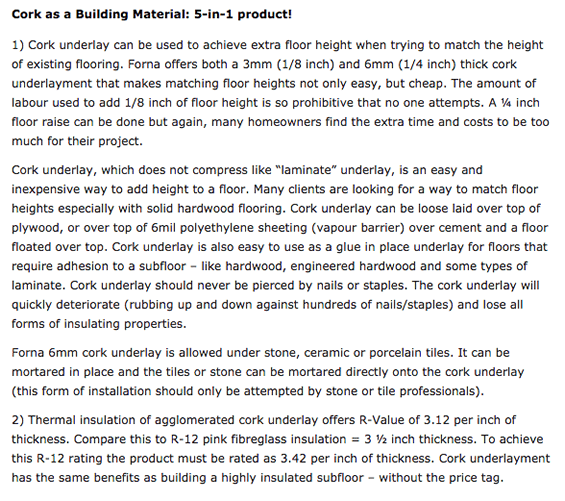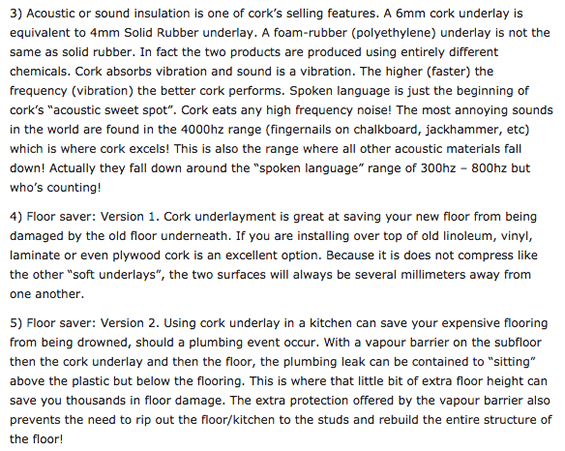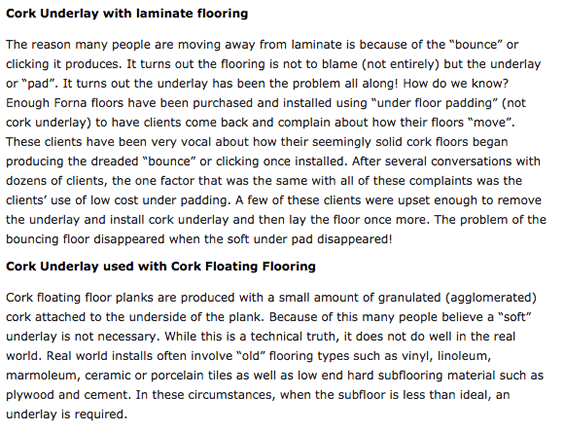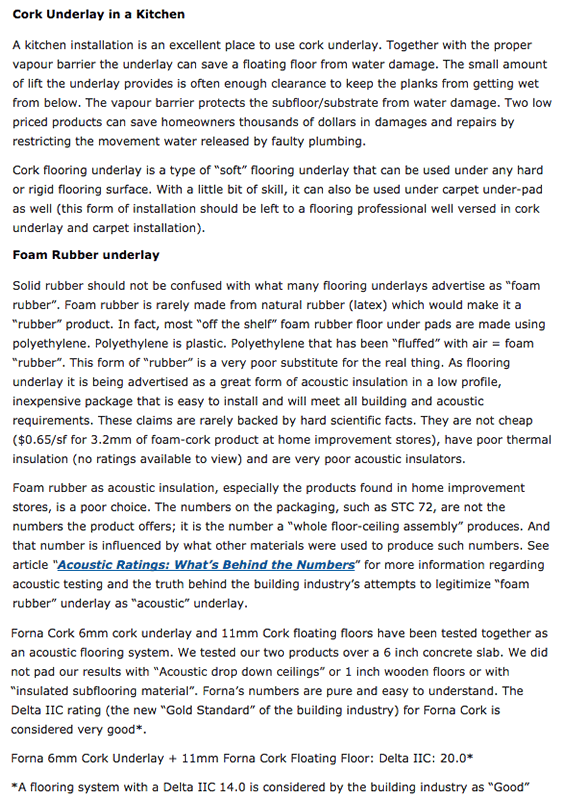Why Cork Underlayment?





why cork underlayment is not “required” but it certainly helps with acoustic insulation and thermal insulation. Why cork underlayment helps reduce sounds/echos travelling as well as keeps spaces warmer in the winter and cooler in the summer. A new build or old doesn’t matter. The question becomes, how much quieter do you want/need? How much warmer would you like it to be without increasing the heating bills?
For houses, the 3mm underlayment is normally enough for most house holds. Busy homes with lots of children/pets/multiple levels with multiple TVs often work best with 6mm cork underlay. If you are looking to add a rental suit at some time...the 6mm cork underlayment is worth it’s weight in gold when it comes to sound barriers.
Q: When walking, there is a slight "give" in places. Should I glue and screw an overlay of 1/4" plywood?
A: Subfloor thickness must be 3/4”; it is very difficult to put down 1/4” thick plywood without blowing through (when the screws go down too deep and come out the other side of the product) it with your screws. That being said, you can certainly give it a go. The subfloor does not need to be “perfect” because you are floating a floor over top. You need to sand down high spots and build up low spots but other than that, you don’t have to worry about puddy/sanding each nail/screw head.
Q: The floors in the original house need to be raised about 1/4", why cork underlayment vs. 1/4” plywood?
A: I would use the 1/4” (6mm) why cork underlayment as a quick, easy, sound absorbing floor raise. It is the simplest, least expensive, least time consuming, most “beneficial” addition you could make to your floors. Again, 1/4” plywood is a tricky install because the screws often blow through to the other side – tremendous frustration together with wasted time, money, effort.
Q: If I do not use cork underlay, do I need to fill and smooth the cracks / splits / joints / knotholes in the plywood subfloors? If so, what is the recommended materials?
A: This all depends on how “bad” the subfloor truly is. If you have high-end, smooth side up 3/4” plywood, you will not have much work to do. Some of the joints may have to be sanded down because of subtle differences in thickness between sheets, but other than that, you won’t have to do too much. If the plywood has lots of knots/gaps/splits or chunks missing, then you will have to patch. The easiest patch material is a wood filler or a form of planipatch (the type doesn’t matter because you are floating the floor over top).
***Q: I have one concrete floor about 15' X 18'. I have glued and screwed 1/4" plywood to it with no vapour barrier between the concrete and the plywood. Is this okay? *** ***A: Wrong thing to do!!! Plywood is rarely glued to cement – rarely. Is this at or below grade? Where is the cement? Did you do moisture testing? What were the readings? What adhesive did you use? Is the adhesive a vapour barrier? To what level will it protect your plywood? Here is what you have just done: you have screwed down a wooden surface to concrete = rotted plywood = improper subfloor preparation = no cork flooring allowed over top. You will need to remove this plywood.
In this case, you should could have done so many different things: 1) Vapour barrier (6mil poly sheeting = black construction plastic) properly sealed with 6mm cork underlayment loose laid over top then cork floor floated over top = NO PROBLEM! 2) Vapour barrier + “sleeper” subfloor on 2” x 6” (or thicker) + floating floor over top = no problem. 3) Vapour barrier + Cork floating floor = no problem.
How to Order
- Ordering Free Sample
- Ordering by Email
- Order Online
Shipping Info
- Pick-up Locations
Contact Info
Tel: 1-604-207-0661
Tel: 1-604-207-9541
Toll Free:
1-877-998-1198
1-866-998-1198
Fax: 1-866-373-6520
Showroom and Warehouse Address:
Cancork Floor INC
#185-1991 Savage Rd.
Richmond BC, V6V 0A4
Canada
About Cork
- Cork Floor Case Study
- Additional Inforemation
Categories
Helpful Links
- Installation
- Measurements and Maintenance
Information
- Info
- Product Information
